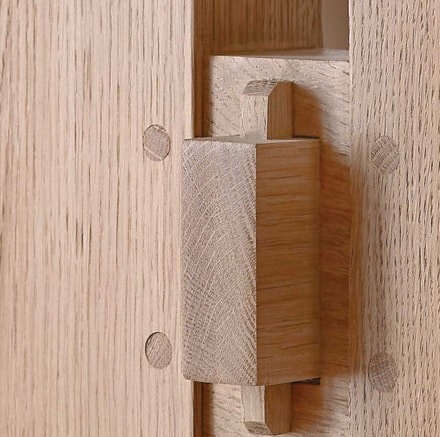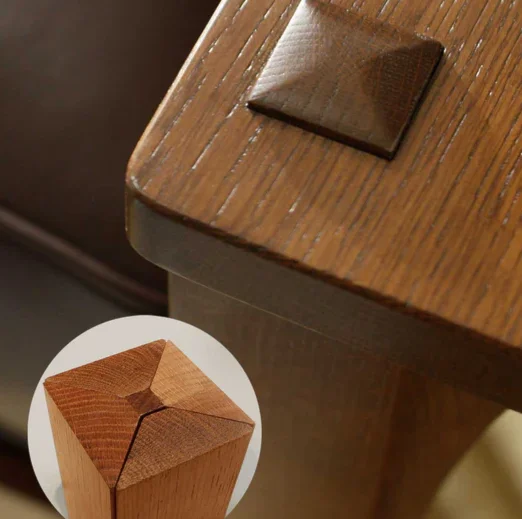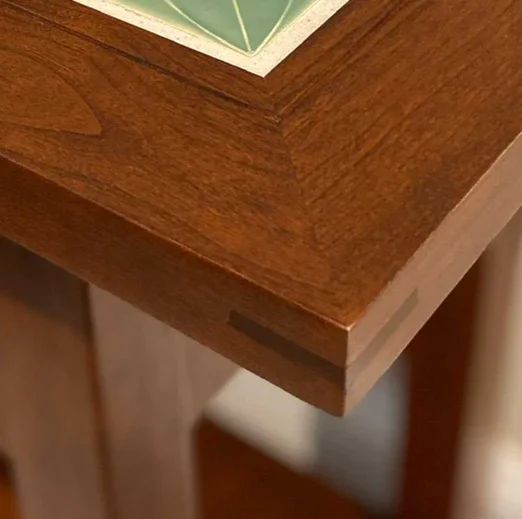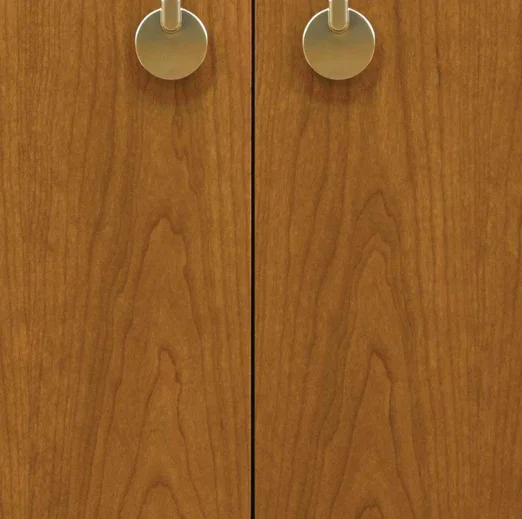
Solid Quartersawn White Oak
A method of sawing oak so the cut is made parallel to the wood’s medullary rays instead of across them. This cut yields a limited quantity of top-grade boards featuring ray flake patterning, and it binds the perpendicular fibers together, giving the oak its amazing strength.

Tenons
A signature element of Stickley construction is the tenon: a board whose ends have been cut for insertion into a mortise. A blind tenon is concealed with the mortise. A through-tenon projects beyond the depth of the mortise. Whether blind, through, pinned, or keyed, tenons are the very best way to join furniture together.

Keyed Tenons
A Stickley keyed tenon is not simply a visual design element. The wedge, or key, is fitted into a slot in the tenon to lock it into place. The key is then glued into place, adding powerful strength to important joints on large pieces of furniture.

Pinned Mortise-and-Tenon Joinery
Most Stickley door joints are tenoned, glued, and pinned with wooden pins. The pins lock the joint, supplying additional strength. This joint would hold together even without the use of glue. Some styles are pinned from the front and are visible, others from the back.

Quadralinear Posts
Four quartersawn solid white oak boards are mitered and then glued around a center post. This distinctive Leopold Stickley construction technique best displays the oak’s ray flake. Simply gluing boards together to make a post yields an unsightly glue line and grain variation. Gustav Stickley achieved a similar effect with oak veneer. This feature is used in Mission styles exclusively.

Side-Hung and Center-Guided Drawers
The center guide keeps drawers from skewing sideways. Side suspension keeps them level when heavily loaded. There are no plastic parts to break, no metal to rust and scratch—just honest-to-goodness hand craftsmanship. The drawer never scrapes the bottom and opens and closes with ease—forever.

Dovetailed Cross Rails
Cross rails on cases are dovetailed into the ends to strengthen the case from side to side. On Mission designs, the dovetail is “blind” or hidden from view. This joint is self locking even without glue, and separation of the end panels is impossible unless the wood is split apart. Dowel joints rely on glue, and glue can fail over time. A dovetail joint cannot fail.

Quarter Rounds & Chamfers
Glass and wooden panels are secured with oak or cherry quarter rounds or chamfers, mitered to fit perfectly and affixed with barely visible pins. We believe the inside of each door should be as handsome as the outside.

Bed Rail Construction
We use top-quality 5/4" solid oak, cherry, and maple for bed rails. Two panhead screws are positioned at the ends of each rail to lock into an iron casting with a tongued slot. The end rails are mortised and tenoned into the posts and secured with wooden pins. As a result, our beds won't wobble or rock.

Splining
The splining of the mitered corners of many mirrors provides the strongest possible corner joint. The chance of a joint ever failing is minimal.

Book-Matched Door Panels
The splining of the mitered corners of many mirrors provides the strongest possible corner joint. The chance of a joint ever failing is minimal.

Ship-Lap Planking
Stickley bookcases often feature ship-lap planking in the back. Individual boards are machined, sanded, finished, and applied one at a time. Together they add character and beauty to a piece.

